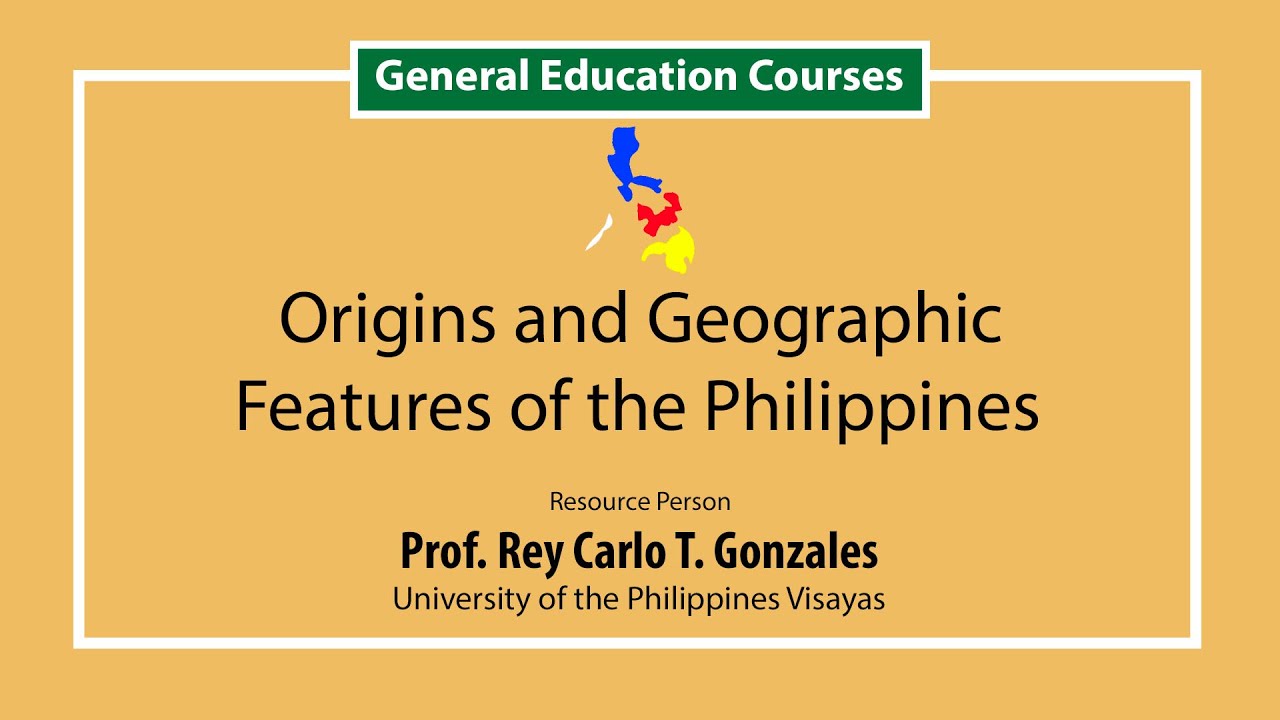Origins and Geographic Features of the Philippines | Prof. Rey Carlo Gonzales
Origins and Geographic Features of the Philippines
Prof. Rey Carlo T. Gonzales
Good day! My name is Rey. Today, we’re going to talk about the origins and geographic features of the Philippines. So, practically we’re gonna try and situate where the Philippines is [located in] Asia and in the world. We’re gonna look at scientific theories on the origin of the Philippines, as well as origin myths of the Philippines. Then, we’re gonna talk about geographic features and characteristics of the Philippines. And finally, we’ll answer the question “how did these features shape us in our history?”.
So, what you see before you is something very familiar. The Philippines is located in Asia and the southeastern portion of Asia. It’s bound in the north by Taiwan, in the West by the West Philippine Sea, in the east by the Pacific, and in the South by the Celebes Sea. Recent developments in politics, however, have changed some of these boundaries, and you could say this is practically what it looks like today.
The Philippines is home to 7,107 Islands but the number actually fluctuates and so it’s really much closer to a recent count of 7,641 Islands. The reason for this is that sometimes the islands submerged because of climate change, or they discover new islands, or they could be taken from us. Approximately, it is 1,000 square miles from north to south. The land surface is 114,830 square miles. The size and diversity of the features of the Philippines translates into things like cultural diversity, biodiversity, the presence of subcultures and cultures and the strong maritime culture. But, we’ll be talking about this later on.
The Philippines has seven mountain ranges. The largest and longest and most majestic of these is the Sierra Madre which you see before you. The tallest peak is Mount Apo which can be found in Davao. Over here in the Island of Panay, we have Mount Madia-as as the tallest peak. The lowest peak on the other hand can be found in the southeastern part of the Philippines which is the Philippine Deep.
Being part of the Ring of Fire, the Philippines is also home to many volcanoes. Some of the most iconic and majestic ones, or what you see before you: Taal Volcano, Mount Mayon which recently erupted, and Mount Pinatubo which erupted in 1991 and was the second most devastating eruption in the century. The closest to the island of Panay is the dormant volcano Kanlaon. It’s also the tallest peak.
The Philippines is what you would regard as riverine. That is to say that most of our aspects of way of life and most of the aspects of culture in our resources, come in and around or are related to the river. Some of the most majestic rivers that we have are Cagayan, iconic ones like Pasig River, or over here in the island of Panay we have the Jalaur River, Iloilo River which cuts across the city, and Panay River.
The climate of the Philippines is tropical. Don’t get yourself fooled though; it is home to some of the most harshest conditions. For instance, there is the dry season and the wet season. The dry season happens somewhere between November and May, and the rainy season happens between June and October. There’s a saying in the Philippines that “If it rains, it pours. If it doesn’t, it droughts.”
Next, we move on into the theories about how the Philippines came to be. So, one theory—which was formulated in 1596—is the continental drift theory. It argues that the world was one large landmass called Pangaea and that, over the next series of millennia, the continents gradually drifted away from each other. So, where does the Philippines fit in here? Sorry for the pun. The Philippines actually floats away from Pangaea, in the same way that the other continents floated away.
Another theory is the land bridge theory, this theory argues that the Philippines is connected to mainland Asia, and that 25,000 years ago you could walk across to Asia using these land bridges. When the ice melted, the water levels rose, and the languages were lost—creating the archipelago that you find today. This theory was critiqued by both Fritjof Voss and Landa Jocano. Fritjof Voss in particular argued that an analysis of the crust in the Philippines and China does not show any connection.
Another theory is the Faulting and Folding theory or Diastrophism theory by Leopoldo Faustino. And, this theory argues that the Earth’s crust constantly shifts—bumps into each other and moves away from each other—and that the islands in the Philippines today are a product of these constant shifting plates.
Another theory proposed by Bailey Willis is the Volcanic Origins Theory and he argued that, much like the islands of Hawaii, the Philippines is a product of volcanic eruptions.
One other theory the teeters between myth and science is the argument that the Philippines was part of a lost continent of Mu. So, if you are aware of the Legend of Atlantis, supposedly, there is another continent in the Pacific called Mu which came crashing down and was lost to the sea forever. And the Philippines is one of those which remained of Mu.
Moving on, we talk about the mythological origins of the Philippines. One common feature of myths about the Philippines is the idea of divine creation. These kinds of myths argue that God, in His infinite wisdom, chose to create the Philippines and its people. In here, you can see a sense of exceptionalism that the early inhabitants of the Philippines acquired. You may also find another form of myths about the Philippines as being born out of the result of a quarrel between divinities. The most familiar of this is the quarrel between the earth and the sky, and how the kite or the eagle or the falcon in some cases caused the sky and the sea to have this big battle and, at the end of it, the Philippines was born. In some other cases you have the argument between two giants, and they throw stones at each other, and these stones become the islands of the Philippines. You also have an Atlas-type narrative which is to say that there is this big, massive, divine being—like, the biggest giant you’ve ever seen—and the Philippines is either part of his body or it is his body which is decomposing. Or, the giant could have probably dropped something and it came crashing down, splintered into pieces and became the islands of the Philippines.
To understand the topography of the Philippines, one of the best examples [that I like] to use in particular is the campus of Miagao. If you look at where the campus of Miagao is, it rests on top of a hill. If you go down, you’ll see the coastal plains close to the town. Immediately to the south, you will find the sea. And immediately to the north, you will find mountains. And all the communities that live here interact with each other as determined by these particular features of topography. So, the Philippines is home to the same kind of diverse topography that you will find here in this campus.
The Philippines has the fifth longest coastline in the world. It’s actually so long, it’s longer than continental US. And you can probably understand that this cost some form of problem for the defenders of the Philippines during the Second World War. They simply had no idea where the Japanese were going to land because of this extensive coastline. It’s also home to a lot of coves, alcoves, groves and base and harbors. Maybe one of the most iconic one that you know about is Manila Bay itself, and it gives you an idea about how history is shaped by a certain geography. For instance, the Americans fought with the Spaniards over Manila Bay, and the Americans fought with the Japanese over Manila Bay, and whoever controlled Manila Bay practically controlled Manila. The Philippines also has a number of lakes. Some of the most iconic of these are Laguna Lake which you see before you, Lanao Lake, and Taal Lake. There are also waterfalls, and some of these [are the most iconic] and scenic beauties that are used in postcards and pictures, for instance, Pagsanjan Falls and Maria Cristina Falls.
The Philippines is home to 10,000 species of plants and ferns, and 900 species of orchids. It’s also home to some of the smallest animals of their species such as the Philippine Tarsier, the Tamaraw and the Pilandok .
If you talk of marine life, the Philippines is home to 2,000 species of fish, 10,000 species of shells and it’s home to the Pandaka Pygmaea, the smallest fish in the world.
The minerals that you can find in the Philippines are not only diverse, they’re also abundant. Gold, for instance, is something that we have been harvesting and mining since before the Spaniards ever came. We also have iron, copper, silver, platinum, chromium, manganese, lead, zinc, petroleum, asbestos, clay, gypsum, lime, salt, sulfur, marble, and adobe stone. Probably, the lasting testament of our relationship with gold can be found in the Oton Death Mask which you see before you.
The Philippines is also home to many scenic beauties. Some of the most iconic ones are the Ifugao Rice Terraces, the Hundred Islands which you find in Pangasinan, the Chocolate Hills, the Underground River in Palawan. One thing that happened to the Chocolate Hills unfortunately is that, during a recent earthquake, the topsoil shifted revealing the earth beneath it, and so the color has already changed.
The most important question to ask about this lecture is, how does geography affect history? How does the land affect us?
One of the consequences, for instance, is occupational. For example, take a look at the sheer number of islands that we have. We have just adapted to this multitude of islands by having a strong maritime culture. Fishing, boat building, communities which live far from the sea have adopted hunting, foraging, or even farming. For instance, among the Ati or the Aeta community, you can still find hunting very much alive.
The geography also affects the kind of industries that we have. For instance, where clay is abundant, you have pottery industries.
In terms of our culture, we are practically very ethnically diverse. Maybe the best example to think about how diverse we are is to look at beauty pageants, especially the international ones where they tend to feature the best of the Philippines. Many of the costumes that have adopted elements from different cultures across the Philippines, sometimes on their own, sometimes combined with each other. This diversity creates a very vibrant Philippines.
On a more serious note, one of the social political consequences of the Philippines is that we develop some kind of regionalism. That is to say that the Philippines is divided according to regions usually in and around ethno-linguistic groups and therefore when we try to think or imagine or draw lines of affiliation around a concept of community, it is based along these same regional lines. In that sense, it’s very difficult to have a sense of nationalism.
It should be said, the Philippines is the first country in Asia to declare itself a nation—the first to conceptualize nationhood. However, we have experienced, what you could probably say as, a delayed sense of nation. And, you can see that happening today because, well, many of the problems that we’re facing today emanate from a lack of this sense of nation. Another consequence of the geography that is socio-political in nature is that it was easier for foreigners to occupy and colonize us—divide and conquer, as they say. Finally—maybe this is a little bit more subtle, but it’s also observable—there is an uneven development of communities between upland and lowland communities here in the Philippines. Although these communities might be closer to each other, it can be really difficult to get one community to access information, services, ideas or even basic resources.
Finally, we go back to where we started.
Let’s take a look at everything that we’ve talked about today. We have tried to situate the Philippines. We have tried to talk about the geography of the Philippines. We have talked about the scientific theories on the origins of the Philippines, as well as origin myths about the Philippines. And finally, we took a look at the consequences of the geography of the Philippines to history.
It is with the intention that this could serve as a framework for understanding, later on in your course, why Filipinos behave the way they do, why things happen the way they did, and how history is shaped.
Thank you very much.
How useful was this resource?
Click on a star to rate it!
Average rating 3 / 5. Vote count: 4
No votes so far! Be the first to rate this post.
We are sorry that this post was not useful for you!
Let us improve this post!
Tell us how we can improve this post?


























